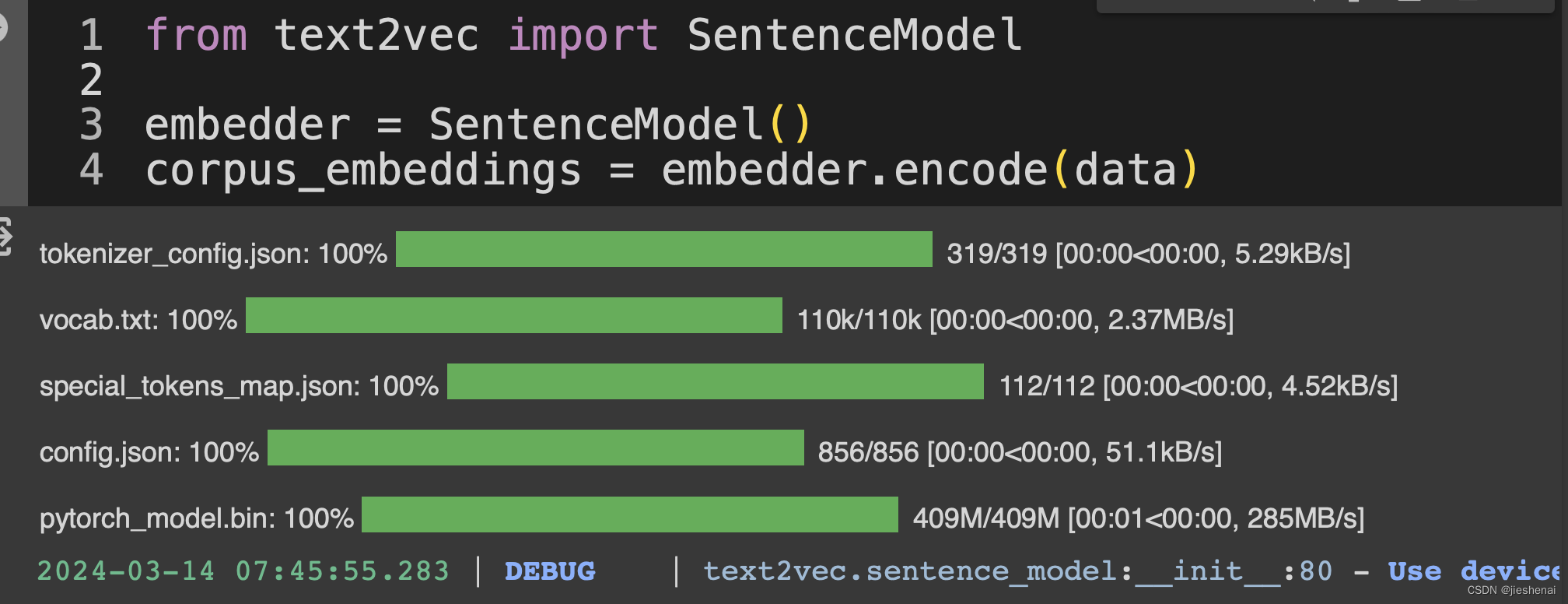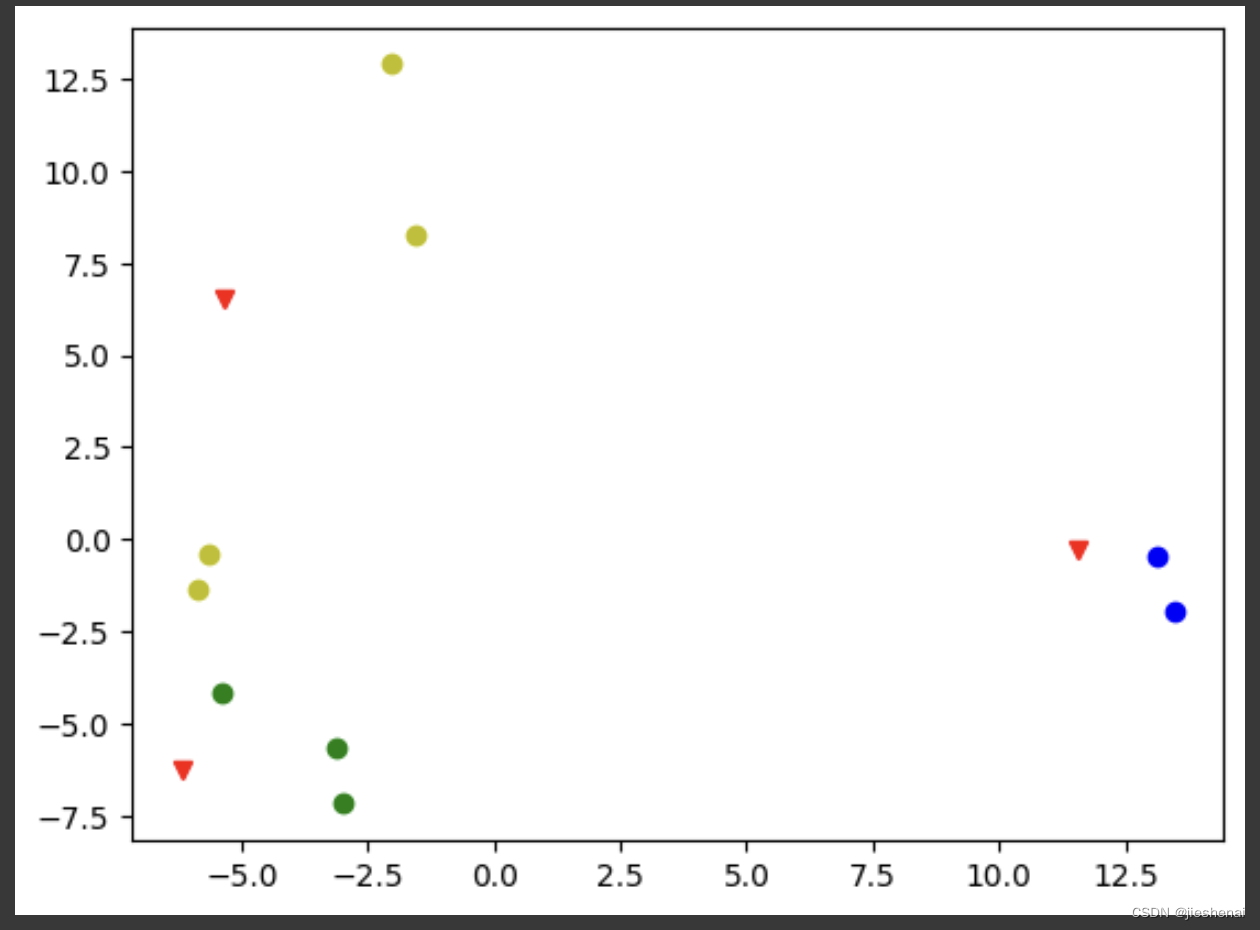文章目录
- 简介
- GPU加速
- 代码实现
- kmeans
- 聚类结果
- kmeans 绘图函数
- 相关资料参考
简介
本文使用text2vec模型,把文本转成向量。使用text2vec提供的训练好的模型权重进行文本编码,不重新训练word2vec模型。
直接用训练好的模型权重,方便又快捷
完整可运行代码如下:
https://github.com/JieShenAI/csdn/blob/main/machine_learning/kmeans_pytorch.ipynb
GPU加速
传统sklearn的TF-IDF文本转向量,在CPU上计算速度较慢。使用text2vec通过cuda加速,加快文本转向量的速度。
传统使用sklearn的kmeans聚类算法在CPU上计算,如遇到大批量的数据,计算耗时太长。
故本文使用kmeans_pytorch包,基于pytorch在GPU上计算,提高聚类速度。
代码实现
装包
pip install fast-pytorch-kmeans text2vec
import torch
import numpy as npfrom text2vec import SentenceModel
不使用SentenceModel模型也可以,在 text2vec 中,还有很多其他的向量编码模型供选择。
文本编码模型
embedder = SentenceModel()
异常情况说明,该模型需要从huggingface下载模型权重,目前被墙了。(请想办法解决,或者尝试其他的编码模型)

语料库如下:
# Corpus with example sentences
corpus = ['花呗更改绑定银行卡','我什么时候开通了花呗','A man is eating food.','A man is eating a piece of bread.','The girl is carrying a baby.','A man is riding a horse.','A woman is playing violin.','Two men pushed carts through the woods.','A man is riding a white horse on an enclosed ground.',
]
corpus_embeddings = embedder.encode(corpus)
# numpy 转成 pytorch, 并转移到GPU显存中
corpus_embeddings = torch.from_numpy(corpus_embeddings).to('cuda')
如下图所示,编码的向量是768纬;
type(corpus_embeddings), corpus_embeddings.shape

kmeans
kmeans_pytorch vs fast-pytorch-kmeans:
在实验过程中,利用kmeans_pytorch 针对30万个词进行聚类的时候,发现显存炸了,程序崩溃退出。30万个词的词向量,占用显存还不到2G,但是运行kmeans_pytorch后,显存就炸了。
fast-pytorch-kmeans不存在上述显存崩溃的问题。本以为词向量很多会跑很长时间,但fast-pytorch-kmeans在非常短的时间内就完成了kmeans聚类。
# kmeans
# from kmeans_pytorch import kmeans
from fast_pytorch_kmeans import KMeansnum_class = 3 # 分类类别数
kmeans = KMeans(n_clusters=num_class, mode='euclidean', verbose=1)# 模型预测结果
labels = kmeans.fit_predict(corpus_embeddings)
聚类程序运行如下:
used 2 iterations (0.3682s) to cluster 9 items into 3 clusters
模型中心点坐标:
kmeans.centroids

聚类结果
class_data = {i:[]for i in range(3)
}for text,cls in zip(corpus, labels):class_data[cls.item()].append(text)class_data
文本聚类结果如下:
0: 女
1:男
2: 花呗

kmeans 绘图函数
封装了KMeansPlot 绘图类,方便聚类结果可视化
from sklearn.decomposition import PCA
import matplotlib.pyplot as pltclass KMeansPlot:def __init__(self, numClass=4, func_type='PCA'):if func_type == 'PCA':self.func_plot = PCA(n_components=2)elif func_type == 'TSNE':from sklearn.manifold import TSNEself.func_plot = TSNE(2)self.numClass = numClassdef plot_cluster(self, result, pos, cluster_centers=None):plt.figure(2)Lab = [[] for i in range(self.numClass)]index = 0for labi in result:Lab[labi].append(index)index += 1color = ['oy', 'ob', 'og', 'cs', 'ms', 'bs', 'ks', 'ys', 'yv', 'mv', 'bv', 'kv', 'gv', 'y^', 'm^', 'b^', 'k^','g^'] * 3for i in range(self.numClass):x1 = []y1 = []for ind1 in pos[Lab[i]]:# print ind1try:y1.append(ind1[1])x1.append(ind1[0])except:passplt.plot(x1, y1, color[i])if cluster_centers is not None:#绘制初始中心点x1 = []y1 = []for ind1 in cluster_centers:try:y1.append(ind1[1])x1.append(ind1[0])except:passplt.plot(x1, y1, "rv") #绘制中心plt.show()def plot(self, weight, label, cluster_centers=None):pos = self.func_plot.fit_transform(weight)# 高纬的中心点坐标,也经过降纬处理cluster_centers = self.func_plot.fit_transform(cluster_centers)self.plot_cluster(list(label), pos, cluster_centers)
kmeans.centroids :是一个高纬空间的中心点坐标,故在plot函数中,将其降纬到2D平面上;
k_plot = KMeansPlot(num_class)
k_plot.plot(corpus_embeddings.to('cpu'),labels.to('cpu'),kmeans.centroids.to('cpu')
)

完整可运行代码如下:
https://github.com/JieShenAI/csdn/blob/main/machine_learning/kmeans_pytorch.ipynb
相关资料参考
- 动手实战基于 ML 的中文短文本聚类
- tfidf和word2vec构建文本词向量并做文本聚类
提到训练word2vec模型,silhouette_score_show(word2vec, 'word2vec')轮廓系数,判断分几个类别最好。 - 机器学习:Kmeans聚类算法总结及GPU配置加速demo
PyTorch kmeans 加速。from scratch 实现; - KMeans算法全面解析与应用案例 通俗易懂的原理讲解
- pytorch K-means算法的实现 底层代码实现
- 【pytorch】Kmeans_pytorch用于一般聚类任务的代码模板 使用pytorch封装的kmeans包实现,包括训练和预测;
- text2vec 包
概念和例题)







)

)

 |前向算法 |一个简单的例子说清计算过程 |一般步骤总结)


)
)


